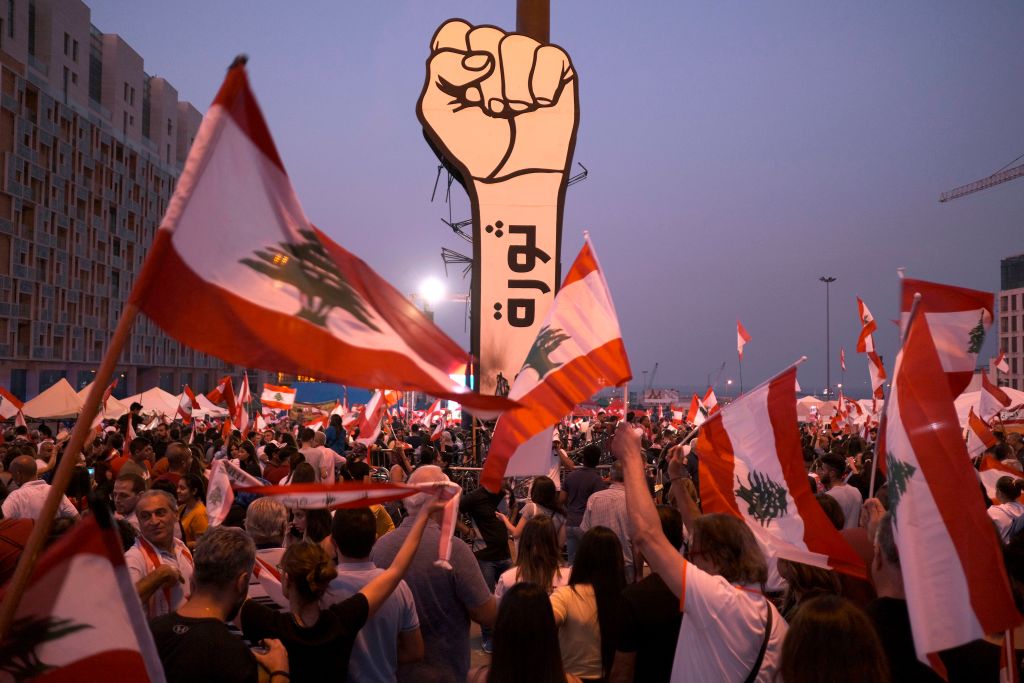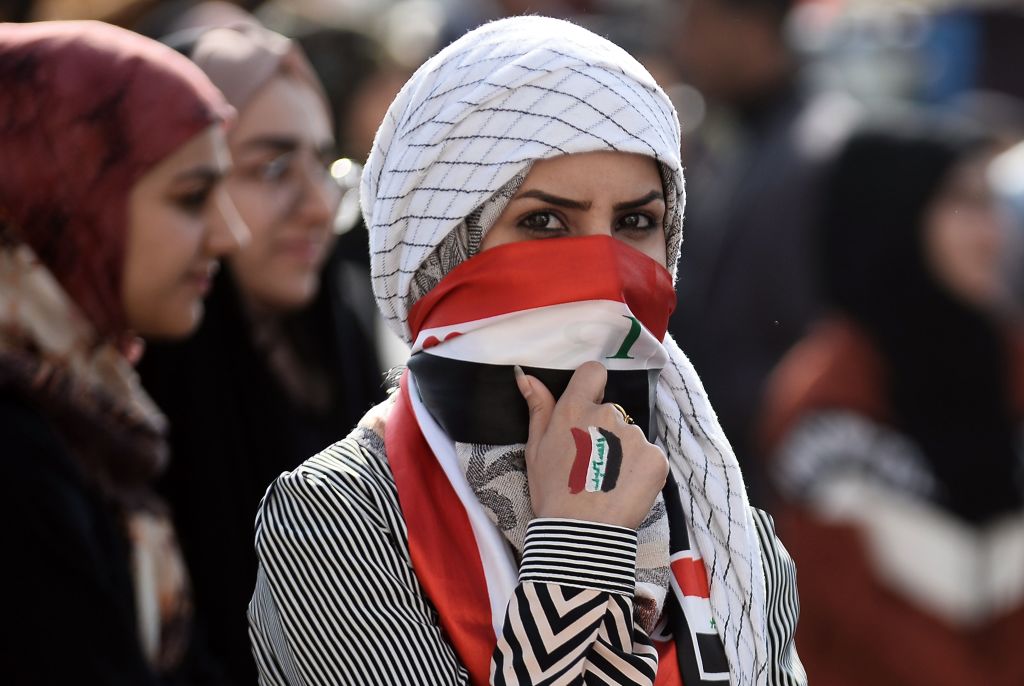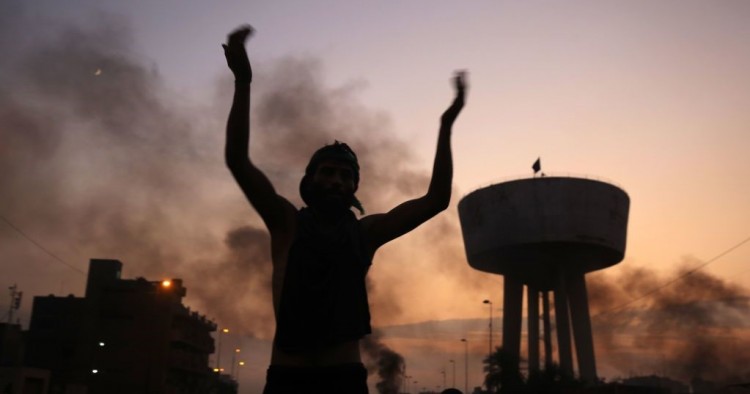Generation change
The three uprisings in Iran, Iraq, and Lebanon represent the revolt of a new generation seeking to build a better future for itself. Since 2011, there have been 11 uprisings in the Middle East and North Africa. Of the major countries of the region, only Morocco, Saudi Arabia, and Turkey have avoided large-scale uprisings. Of the smaller countries, only Jordan and five of the Gulf Cooperation Council states have avoided uprisings.
All 11 uprisings have similar drivers: the explosive dysfunction of high demographic growth, low levels of economic development and job creation, poor government performance and services, and high levels of corruption and inequality. This has led to the breakdown of the socio-economic contract, a decline of legitimacy, and an increased reliance on repression to maintain order and control. There is also a growing rift between the world view of the older ruling generations and a younger generation putting forward different values, identities, and worldviews that challenge the status quo.
The younger generation is hit particularly hard by low levels of economic development and scarce job opportunities. At the same time, it is empowered by the technology of the internet and social media, which provide new avenues for information, socialization, and mobilization. In all 11 countries, the absence of working political systems to peacefully mediate these generational and political pressures and promote gradual political change resulted in the eruption of uprisings.
Three-ring crisis: Iran and its revolting imperium
The three cases we are examining — Iran, Iraq, and Lebanon — are, in many ways, similar to the other eight cases in terms of basic drivers and dysfunctions. A peculiarity that these three share is that they are happening in what we might call the Iranian axis of power. And it is interesting that Iran is losing just at a time that it is also winning in the broader sense.
If we pull back and look at Iran’s global standing, comparing 2003 to 2019, we can see that it has scored historic geopolitical victories. Iran is now a dominant power over the entire Levant, including Iraq, Syria, and Lebanon, and has also gained a historic and unexpected foothold on the southern border of Saudi Arabia in Yemen and overlooking the Bab el-Mandeb Strait over the Red Sea. Up to a few months ago, Tehran appeared to be managing the U.S. “maximum pressure” campaign quite well. It had maintained relative calm at home, but more importantly it was dictating the time, place, and nature of escalations in the Persian Gulf and against American, UAE, and Saudi assets or targets.
It had also managed to effectively neutralize the positions of the UAE and Saudi Arabia, making them distance themselves from the Trump administration and the maximum pressure campaign. This was accomplished after obvious Iranian threats toward both the UAE and Saudi Arabia, as well as the attack on Aramco oil fields in September. In that sense, it could point to significant gains within the Gulf region itself.
Now, however, it is facing the biggest domestic challenge since the 1979 revolution, and it is seeing a historic shift in its critical neighbor, Iraq. There is a new narrative emerging, particularly among Shiite youth in Iraq — a narrative that is fully divorced from the rhetoric of the Islamic Republic and the Welayat al-Faqih. This new narrative is eclipsing the one that had been forged by the Islamic Republic and revolution over the past 40 years and it is gaining resonance between the two Shiite heartlands in Iraq and Iran. Finally, Iran is also facing a challenge in Lebanon, although compared to the first two, this one is relatively minor.
Roots of rebellion
How did we get here? All three uprisings are not entirely new. They all have recent but significant historical roots. Iran has had repeated major uprisings since that of 2009, after the contested elections that year. Iraq has had repeated uprisings since 2011 and again in 2015 and 2016. Lebanon has had protests that resemble in identity and tone the current much wider uprising, beginning with the “You Stink” movement in 2014 and other protests against government corruption and ineptitude.
In other words, the basic protest or opposition narratives have taken shape over time. The U.S. maximum pressure campaign has been a recent contributing factor and is relevant to current developments, but it is hard to say if it is decisive or not.
All three uprisings certainly had proximate triggers. The Iranian protests were triggered by a large gas price hike. That hike itself is interesting to examine in terms of how it may have been related to intra-elite infighting and attempts by President Hassan Rouhani to put pressure on the Revolutionary Guard and other hardliners. In Iraq and Lebanon, both had parliamentary elections in 2018. One can say that the population waited to see if the results of those elections, in terms of a new parliament and a new government, would bring positive changes in the country’s governance. In both cases, a year after the election, and months after the formation of the government, the population was gravely disappointed and felt that the urgency of the situation would not allow another three years of waiting for the next parliamentary elections. In both cases, the population pulled the plug.

State and militia response
The protests have been handled quite differently by state authorities — and by Iran-backed militias — in the three cases. Indeed, one can see a spectrum of reaction between Iran, Iraq, and Lebanon. In Iran, the state reaction was all hard power and “shoot-to-kill” with absolutely no concessions contemplated or offered to the protesters. Iran might be learning the “lesson” of the Syrian uprising. The Iranian regime unified in the face of the protesters, with President Rouhani even raising his voice against them and in support of the crackdown. The regime was indeed congratulating itself on its “successful” handling of the uprising.
In Iraq, we initially saw extensive use of hard power against protesters, mainly by members of militias, apparently encouraged by Iran’s Qassem Soleimani, head of the Revolutionary Guard Quds Force. But the Iraqi political system also reacted “politically” with the resignation of the prime minister and the government. This was effectively a concession to the protesters and a pivot to looking for a new prime minister, a new government, and possibly early elections.
In Lebanon, the protests and the response has been largely peaceful, although with significant breaches. The Lebanese Armed Forces and the Internal Security Forces have generally stood protective of the protesters, although some security units, such as the “Parliament Security” detail that reports to the speaker of the parliament, have repeatedly used violence. The army has made it clear that it will protect the civilian protesters while also indicating that it wants to keep the main roads and arteries open. Hezbollah and Amal have tried some hard power approaches. They have brought their thugs into the streets and have been more ruthless in their own community, but have not been very effective in other regions and communities of the country. The response in Lebanon has been mainly political, with the prime minister and the government resigning. Like in Iraq the president and parliament are now tasked with designating a new prime minister who then would form a new government.
What is slightly different about the Lebanese case than the other two is the urgency of the economic and banking collapse that is taking place. It threatens to create massive social and economic pain, and dramatically raise the number of unemployed as well as the poverty rates. This could potentially send not only Syrian refugees, but also Lebanese refugees heading west for relief. It might also cause security concerns as desperate and poor people struggle to make ends meet.
Future unfolding
When looking to near-future scenarios for these cases, in Iran the system has proven extremely rigid. It has chosen to confront the protests with direct and excessive use of force. It has offered no political pathway to respond to protesters’ demands, but rather views the allowing of any protest as a gateway to a larger revolution and a potential threat to the entire regime. In Iran one can expect recurring protests of this nature, but there will certainly be no near-term political accommodation and there is little potential for gradual political change.
That said, the nature of the crisis in Iran does indicate that the risk or possibility of a large-scale and perhaps regime-ending revolution is not to be discounted — although impossible to predict. The critical juncture will be at the time of the death of the supreme leader and the succession crisis that his passing will create, if succession has not been already arranged before then.
Lessons from the history of revolutions around the world indicate three main elements that render them potentially successful. The first is strong discontent from below, and that certainly exists in Iran. The second is divisions and infighting at the top of the state or regime, and that also exists in Iran. The third is a triggering crisis — often a succession crisis or other major triggering event —whether external or internal. But for now, change of regime in Iran or even change of foreign policy should not be expected.
In the foreign policy sphere Iran will remain desperate for economic relief, but there is little prospect for engagement between Iran and the U.S. before the 2020 elections. On the U.S. side, the uprisings in Iran, Iraq, and Lebanon have hardened the American position and show that the maximum pressure campaign is paying off handsomely; the U.S. is likely to keep up the pressure until Iran is really ready to bend in much deeper and wide-ranging ways than it has indicated so far.
After the U.S. elections, however, it could be a different story. The maximum pressure campaign and the acute crisis that Iran finds itself in indicates there is serious potential in 2021 for an attempt at a deep and powerful negotiation with Iran over not only its nuclear program and missile program, but also its proxy armed forces in Lebanon, Syria, and Iraq, and its undefined presence in Yemen. 2021 might be a year where a grand negotiation and bargain with Iran could be attempted. If it works, it would be a positive game changer for the region. If it fails, Iran’s isolation may continue indefinitely, similar to the cases of North Korea and Cuba. Of course much will depend on who is sitting in the White House in January 2021.
The near-future scenarios in Iraq and Lebanon are interestingly similar to one another: They both face the challenge of forming a new government that would go some way in satisfying domestic and international expectations, but any government will remain under the overall authority of a parliament that is still fully in the hands of the corrupt elite that people have revolted against. But a government urgently needs to be formed to respond to protesters’ demands and to get a handle on the acute social and economic challenges facing populations in both countries.
Neither population appears willing to wait for parliamentary elections in 2022; instead, they are demanding early elections based on a new election law. In both countries, the government formation juncture, as well as the election juncture, are very important.
The challenge for these protest movements and for the young generation forging a new path in both countries is one that is similar to those faced by national protest movements in other Arab Spring uprisings. Can the generation that brought millions to the streets also get millions to the polls? Whether or not these massive protest movements can transform into effective, sustained, and long- lasting political movements able to shape and participate in governments, as well as contest and win significant numbers of seats in parliamentary elections, remains a critical question.
It is interesting that similar generational movements from the 1920s to the 1970s found particular political and ideological forms to sustain themselves and to turn into lasting political institutions. Perhaps in this post-ideological and post-modern moment, the shift from spontaneous and large-scale protests driven by social media mobilization, as well as agreement on what the people are against, is difficult to translate into lasting political organizations that can crystallize and communicate what they are for, as well as vet and put forward representatives to be effective members of government or stand for parliamentary elections.
The uprisings in these three countries, as well as those in the other eight countries of the Middle East, all indicate that the people of the region want change and want to move in a positive direction toward good government, accountability, serious economic development, job creation, and social justice. It remains the case that the majority of the states of the region, with a few exceptions, are not providing a workable pathway forward.
Let us hope that the populations in Lebanon and Iraq, which at the end of the day exist in states that have a modicum of constitutional, electoral democratic order, can translate this new national energy into meaningful change of government, as well as a generational and political change within the parliaments of both countries. In Iran the challenge of the population is much harder and darker, and faces the bullets and bayonets of a regime that perhaps realizes that time and the new generation is passing it by. Like the regime in Syria, it will muster all the military means of repression to maintain itself in power.

Outside looking in
The U.S. and the international community should stand with the rising populations of these three countries. In the case of Lebanon, the international community should welcome these protests and encourage the ruling class to form a government of effective, independent, and capable ministers in alignment with the people’s wishes. They should press that government to effectively and quickly undertake the necessary reforms, stemming the ongoing economic collapse, dramatically reducing corruption, and improving governance. If that is the case then the international community should stand ready to extend a hand and provide assistance to reduce the impact of the economic and banking crisis and provide the reform and infrastructure and investment packages that were discussed and promised in last year’s CEDRE conference. The international community should also encourage the government to consider early elections for parliament in which this newly mobilized public can put forward its own representatives.
In Iraq the international community should insist on an immediate and long-lasting cessation of any use of force against unarmed civilians. Like in the case of Lebanon, they should also encourage political institutions to move quickly to form an independent and capable government that can rapidly take effective steps against corruption and to improve governance and positively impact the social and economic conditions. Here too the international community should encourage the new government to hold early elections in order to allow its newly mobilized generation to express itself in new representatives and new political platforms.
In Iran, the challenge of course is much more difficult. The international community should have a very strong reaction to the entirely excessive and brutal use of force by the Iranian state. The U.S. of course is already implementing a maximum pressure campaign against Iran, but the EU must also make it clear that such use of force means a cessation of the goodwill and cooperation that Europe has exhibited so far.
In the long term, perhaps every crisis is an opportunity. The nuclear deal of 2015 was supposed to encourage Iran to moderate its behavior and was supposed to lead in the next (Clinton) administration to talks over Iran’s missile program and its proxy armies around the Middle East. This of course did not happen, but rather the reverse did. In this sense the JCPOA had a similar effect to the Camp David Accords between Egypt and Israel. That agreement in 1979 was supposed to be important in itself, but also an agreement that would enable, as a later step, negotiation over the wider issue of Israeli-Palestinian peace and a two-state solution. Instead, it led to an escalation of settlement building in the West Bank to such a degree that resolution of the Israeli-Palestinian issue has become almost impossible. Similarly, Iran took advantage of the 2015 nuclear deal to double down on its missile program and its deployment of proxy militias throughout the Middle East. Iran indeed needs to decide whether it is a state serving its people or an ongoing revolution seeking to change the region and the world.
It is not unreasonable for the U.S. and other members of the international community to say to Iran “Enough is enough.” If it wants to be an accepted and respected player in the international community, it must agree to abide by international norms. This means not only agreement over the nuclear program and other matters, but also a fundamental agreement to end its support for and leadership of proxy armies outside of its borders. If Iran is willing to come to such a historic realization, then it is up to the international community, as well as the main regional players in its neighborhood, to normalize relations with Iran and work together to create a stable, peaceful, and prosperous Middle East that would serve not only the interests of the Iranian people but the interests of all other peoples in the region as well.
Paul Salem is the president of MEI. The views expressed in this article are his own.
Photo by AHMAD AL-RUBAYE/AFP via Getty Images
The Middle East Institute (MEI) is an independent, non-partisan, non-for-profit, educational organization. It does not engage in advocacy and its scholars’ opinions are their own. MEI welcomes financial donations, but retains sole editorial control over its work and its publications reflect only the authors’ views. For a listing of MEI donors, please click here.













